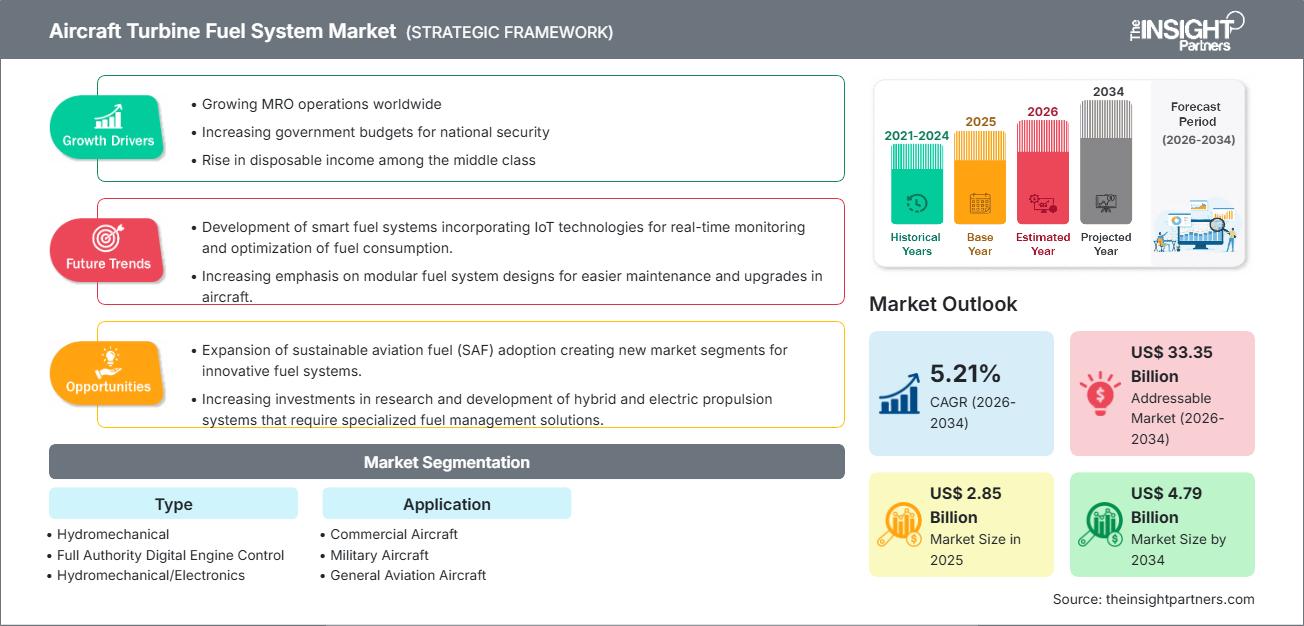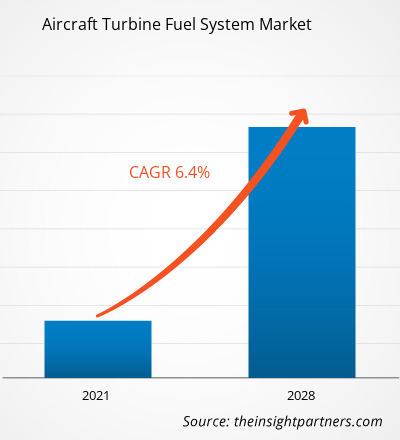Der Markt für Flugzeugturbinentreibstoffsysteme wird bis 2034 voraussichtlich ein Volumen von 4,79 Milliarden US-Dollar erreichen, gegenüber 2,85 Milliarden US-Dollar im Jahr 2025. Es wird erwartet, dass der Markt im Zeitraum 2026–2034 eine durchschnittliche jährliche Wachstumsrate (CAGR) von 5,21 % verzeichnen wird.
Marktanalyse für Flugzeugturbinentreibstoffsysteme
Die Marktprognose für Flugzeugturbinentreibstoffsysteme deutet auf ein stetiges Wachstum hin, vor allem getrieben durch den zunehmenden globalen Flugverkehr und ambitionierte Flottenmodernisierungsprogramme zur Steigerung der betrieblichen Effizienz. Unterstützt wird dies zusätzlich durch globale Nachhaltigkeitsinitiativen wie die Einführung von SAF (Sustainable Air Fuel), die Entwicklung von Wasserstoffantrieben und strenge globale Emissionsnormen. Darüber hinaus fördert dieser Fokus auf Umweltauflagen und Treibstoffeffizienz Innovationen bei FADEC (Flight-Advanced Energy Delivery Control) und fortschrittlichen elektronischen Messsystemen und stärkt damit die Perspektiven für die zivile und militärische Luftfahrt.
Marktübersicht für Flugzeugturbinentreibstoffsysteme
Die Treibstoffsysteme von Flugzeugturbinen sind hochkritische, komplexe Systeme aus Komponenten wie Pumpen, Dosiereinheiten, Filtern und FADEC-Systemen, die für die präzise Speicherung, Aufbereitung und Zufuhr von Treibstoff zu den Triebwerken verantwortlich sind. Diese Systeme sind von entscheidender Bedeutung für die Flugsicherheit, optimale Triebwerksleistung und die Einhaltung sich stetig weiterentwickelnder Umweltstandards. Moderne elektronische und hybride Treibstoffmanagementsysteme ersetzen zunehmend traditionelle hydromechanische Systeme und bieten höhere Effizienz, verbesserte Diagnosemöglichkeiten und die Flexibilität, neue Treibstoffarten zu verarbeiten. Dadurch sind sie für Flugzeuge der nächsten Generation in allen Segmenten unverzichtbar.
Passen Sie diesen Bericht Ihren Anforderungen an.
Sie erhalten eine kostenlose Anpassung aller Berichte – einschließlich Teilen dieses Berichts, Länderanalysen und Excel-Datenpaketen – sowie attraktive Angebote und Rabatte für Start-ups und Universitäten.
Markt für Flugzeugturbinentreibstoffsysteme: Strategische Einblicke

-
Ermitteln Sie die wichtigsten Markttrends dieses Berichts.Diese KOSTENLOSE Probe beinhaltet eine Datenanalyse, die von Markttrends bis hin zu Schätzungen und Prognosen reicht.
Markttreiber und Chancen für Flugzeugturbinentreibstoffsysteme
Markttreiber:
- Zunehmender globaler Flugverkehr und Flottenausbau: Die anhaltende Erholung und das Wachstum des Passagier- und Frachtluftverkehrs sowie umfangreiche militärische Modernisierungsprogramme erfordern die Lieferung zuverlässiger und leistungsstarker Treibstoffsysteme für neue Flugzeugbestellungen.
- Regulatorische Vorgaben für Treibstoffeffizienz und Emissionskontrolle: Strenge Vorschriften auf globaler Ebene von Organisationen wie der ICAO und der EU veranlassen Flugzeughersteller dazu, hochentwickelte FADEC- und elektronische Systeme zur Verbrennungskontrolle und Reduzierung der Umweltbelastung einzusetzen.
- Modernisierung und Nachrüstung alternder Flotten: Der Drang, ältere zivile und militärische Flugzeuge mit neueren, effizienteren und SAF-kompatiblen Treibstoffsystemen auszustatten, führt zu einer erheblichen Nachfrage im Aftermarket-Segment.
Marktchancen:
- Einführung von nachhaltigen Flugkraftstoffen (SAF) und Wasserstoffantrieb: Der Wandel hin zu alternativen Kraftstoffen schafft enorme Möglichkeiten für Anbieter, neue, vollständig kompatible Kraftstoffdosier-, Pump- und Inertisierungssysteme zu entwickeln und zu zertifizieren, die in der Lage sind, SAF und kryogenen Wasserstoff zu verarbeiten.
- Entwicklung fortschrittlicher FADEC- und elektronischer Kraftstoffdosiersysteme: Laufende Forschung und Entwicklung im Bereich elektronischer Steuergeräte und Hybridsysteme können eine noch genauere Kraftstoffsteuerung, eine adaptive Motorsteuerung und eine weitere Reduzierung des Kraftstoffverbrauchs erreichen.
- Integration von intelligenten Sensoren und vorausschauenden Wartungstechnologien: Die Implementierung sensorbasierter Diagnostik und IoT-Konnektivität in Treibstoffsystemen unterstützt eine proaktive Wartungsplanung, reduziert ungeplante Ausfallzeiten und verbessert die allgemeine Betriebssicherheit für Fluggesellschaften.
Marktbericht für Flugzeugturbinentreibstoffsysteme: Segmentierungsanalyse
Der Marktanteil wird in verschiedenen Segmenten analysiert, um ein besseres Verständnis seiner Struktur, seines Wachstumspotenzials und der aufkommenden technologischen Trends zu ermöglichen. Nachfolgend ist der in den meisten Branchenberichten verwendete Standardansatz zur Segmentierung dargestellt:
Nach Typ
- Hydromechanisch
- Vollständige digitale Motorsteuerung (FADEC)
- Hydromechanisch/Elektronisch (Hybridsysteme)
Durch Bewerbung
- Verkehrsflugzeuge
- Militärflugzeuge
- Allgemeine Luftfahrtflugzeuge
Nach Geographie:
- Nordamerika
- Europa
- Asien-Pazifik
- Süd- und Mittelamerika
- Naher Osten und Afrika
Markt für Flugzeugturbinentreibstoffsysteme – Regionale Einblicke
Die regionalen Trends und Einflussfaktoren auf den Markt für Flugzeugturbinentreibstoffsysteme im gesamten Prognosezeitraum wurden von den Analysten von The Insight Partners eingehend erläutert. Dieser Abschnitt behandelt außerdem die Marktsegmente und die geografische Verteilung des Marktes für Flugzeugturbinentreibstoffsysteme in Nordamerika, Europa, Asien-Pazifik, dem Nahen Osten und Afrika sowie Süd- und Mittelamerika.
Berichtsumfang zum Markt für Flugzeugturbinentreibstoffsysteme
| Berichtattribute | Details |
|---|---|
| Marktgröße im Jahr 2025 | 2,85 Milliarden US-Dollar |
| Marktgröße bis 2034 | 4,79 Milliarden US-Dollar |
| Globale durchschnittliche jährliche Wachstumsrate (2026 - 2034) | 5,21 % |
| Historische Daten | 2021-2024 |
| Prognosezeitraum | 2026–2034 |
| Abgedeckte Segmente |
Nach Typ
|
| Abgedeckte Regionen und Länder |
Nordamerika
|
| Marktführer und wichtige Unternehmensprofile |
|
Marktdichte der Akteure im Markt für Flugzeugturbinentreibstoffsysteme: Auswirkungen auf die Geschäftsdynamik verstehen
Der Markt für Flugzeugturbinentreibstoffsysteme wächst rasant, angetrieben durch die steigende Nachfrage der Endverbraucher. Gründe hierfür sind unter anderem sich wandelnde Verbraucherpräferenzen, technologische Fortschritte und ein wachsendes Bewusstsein für die Vorteile des Produkts. Mit steigender Nachfrage erweitern Unternehmen ihr Angebot, entwickeln innovative Lösungen, um den Kundenbedürfnissen gerecht zu werden, und nutzen neue Trends, was das Marktwachstum zusätzlich beflügelt.

- Verschaffen Sie sich einen Überblick über die wichtigsten Akteure im Markt für Flugzeugturbinentreibstoffsysteme.
Marktanteilsanalyse für Flugzeugturbinentreibstoffsysteme nach Regionen
Nordamerika
- Marktanteil: Besitzt weltweit den größten Marktanteil, was auf die Präsenz großer Flugzeughersteller, hohe Verteidigungsausgaben und fortschrittliche MRO-Kapazitäten (Wartung, Reparatur und Überholung) zurückzuführen ist, die umfangreiche Nachrüstungsprogramme unterstützen.
- Trends: Starke Verbreitung von Technologien zur vorausschauenden Wartung und Fokus auf die Integration von FADEC-Systemen mit fortschrittlichen Avionikplattformen.
Europa
- Marktanteil: Verfügt über einen bedeutenden Marktanteil, unterstützt von großen europäischen Luft- und Raumfahrt- sowie Verteidigungsunternehmen und starken Forschungs- und Entwicklungsinitiativen mit Schwerpunkt auf nachhaltigem Flugkraftstoff (SAF) und Wasserstoffantriebssystemen.
- Trends: Führungsrolle bei der Entwicklung von umweltverträglichen Kraftstoffsystemen der nächsten Generation zur Erfüllung strenger EU-Vorgaben.
Asien-Pazifik
- Marktanteil: Voraussichtlich die am schnellsten wachsende Region, angetrieben durch eine massive Expansion der kommerziellen Flugzeugflotte in wachstumsstarken Ländern wie China und Indien sowie durch die steigende Nachfrage nach innerregionalen Flugreisen.
- Trends: Deutliche Investitionen in die Infrastruktur von MRO-Einrichtungen und die zunehmende Beschaffung neuer, treibstoffeffizienter Flugzeugmodelle.
Süd- und Mittelamerika
- Marktanteil: Aufstrebender Markt mit stetigem Wachstum, das durch die Modernisierung regionaler Flugflotten und staatliche Investitionen in militärische Beschaffungsprogramme getrieben wird.
- Trends: Fokus auf kosteneffiziente und zuverlässige Treibstoffsystemlösungen für Regional- und allgemeine Luftfahrtflugzeuge.
Naher Osten und Afrika
- Marktanteil: Ein sich entwickelnder Markt mit starkem Wachstumspotenzial aufgrund massiver Infrastrukturinvestitionen in Luftfahrtdrehkreuze und der Expansion großer internationaler Fluggesellschaften, die die neueste Flugzeugtechnologie benötigen.
- Trends: Hohe Nachfrage nach fortschrittlichen, hochzuverlässigen Kraftstoffsystemen, die unter vielfältigen und oft anspruchsvollen Umweltbedingungen optimal funktionieren.
Marktdichte der Akteure im Markt für Flugzeugturbinentreibstoffsysteme: Auswirkungen verstehen
Der Markt für Flugzeugturbinentreibstoffsysteme ist aufgrund hoher Markteintrittsbarrieren im Zusammenhang mit Sicherheitszertifizierungen (z. B. FAA, EASA) und langen Entwicklungszyklen mäßig konsolidiert. Globale Akteure wie Eaton, Honeywell, Parker Hannifin, Safran und Woodward dominieren den Markt und nutzen ihre bestehenden Beziehungen zu großen Flugzeugherstellern.
Dieses wettbewerbsintensive Umfeld zwingt die Anbieter dazu, sich durch Folgendes zu differenzieren:
- Kontinuierliche Integration von SAF- und wasserstofffähigen Treibstoffsystemen zur Erfüllung künftiger Dekarbonisierungsvorgaben und zur Sicherung von Positionen auf Flugzeugplattformen der nächsten Generation.
- Expansion in wachstumsstarke Schwellenländer durch strategische Partnerschaften mit lokalen MRO-Anbietern und Rüstungsunternehmen.
- Entwicklung fortschrittlicher FADEC- und elektronischer Steuerungstechnologien, die überlegenes Motormanagement, Diagnosemöglichkeiten und Betriebskosteneinsparungen bieten.
Wichtige Unternehmen, die auf dem Markt für Flugzeugturbinentreibstoffsysteme tätig sind
- Eaton
- Honeywell International Inc.
- Jihostroj
- Mascott Equipment Co.
- Parker Hannifin Corp.
- Safran
- Triumph Group, Inc.
- Turbine Fuel Systems Inc.
- Woodward Inc.
Hinweis: Die oben aufgeführten Unternehmen sind nicht in einer bestimmten Reihenfolge geordnet.
Neuigkeiten und aktuelle Entwicklungen auf dem Markt für Flugzeugturbinentreibstoffsysteme
- Eaton beteiligt sich am EU-finanzierten Forschungs- und Entwicklungsprojekt HYLENA zur Entwicklung wasserstoffelektrischer Antriebssysteme: Eaton gab seine Teilnahme an dem HYLENA-Projekt bekannt, das sich auf die Integration von Festoxidbrennstoffzellen mit Turbomaschinen für CO₂-freie Kurz- und Mittelstreckenflüge konzentriert. Das Unternehmen liefert weiterhin fortschrittliche Kraftstoffpumpen und -verteilungssysteme, die mit nachhaltigem Flugkraftstoff (SAF) kompatibel sind.
- Honeywell hat die UOP eFining™-Technologie eingeführt und die SAF Technology Alliance gegründet: Honeywell präsentierte UOP eFining™, ein Verfahren zur Umwandlung von E-Methanol in E-SAF, wodurch die Treibhausgasemissionen um bis zu 88 % reduziert werden. Darüber hinaus ging Honeywell Partnerschaften mit Johnson Matthey, Gidara Energy und Samsung E&A ein, um die SAF Technology Alliance zu gründen und umfassende Lösungen für die Biomasse-zu-SAF-Produktion anzubieten.
- Safran hat im Rahmen des Projekts BeautHyFuel erfolgreich einen wasserstoffbetriebenen Turbinenmotor am Boden getestet: Mit diesem Test erreichte Safran einen wichtigen Meilenstein und bekräftigte sein Engagement für nachhaltige Antriebstechnologien. Darüber hinaus präsentierte das Unternehmen biokompatible Kraftstoffverteilungs- und -managementsysteme für zivile und militärische Flugzeuge.
- Parker Hannifin sicherte sich milliardenschwere Aufträge für Treibstoffsysteme für Airbus A350 und COMAC C919: Parker Aerospace diversifizierte sein Portfolio weiter durch die Lieferung integrierter Treibstoff- und Inertisierungssysteme für die wichtigsten Flugzeugprogramme und stärkte gleichzeitig seine Position im Bereich fortschrittlicher Treibstoffsystemtechnologien.
- Die Triumph Group hat eine langfristige strategische Vereinbarung mit Honeywell unterzeichnet und die FADEC-Entwicklung vorangetrieben: Triumph gab eine Partnerschaft mit Honeywell zur Herstellung von Förderpumpen und FADEC-Einheiten für T55-Hubschraubertriebwerke und F124/HTF7000-Triebwerke bekannt. Das Unternehmen setzt außerdem seine Forschung und Entwicklung im Bereich von Treibstoffpumpen der nächsten Generation für Kampfflugzeuge und elektronischen Triebwerkssteuerungen fort.
Marktbericht über Flugzeugturbinentreibstoffsysteme: Abdeckung und Ergebnisse
Der Bericht „Marktgröße und Prognose für Flugzeugturbinentreibstoffsysteme (2021–2034)“ bietet eine detaillierte Analyse, die Folgendes umfasst:
- Marktgröße und Prognose für Flugzeugturbinentreibstoffsysteme auf globaler, regionaler und Länderebene für alle wichtigen Segmente.
- Markttrends im Bereich Flugzeugturbinentreibstoffsysteme sowie Marktdynamiken wie Treiber, Hemmnisse und wichtige Chancen.
- Detaillierte PEST- und SWOT-Analyse.
- Marktanalyse für Flugzeugturbinentreibstoffsysteme mit Fokus auf wichtige Markttrends, globale und regionale Rahmenbedingungen, Hauptakteure, Vorschriften und aktuelle Marktentwicklungen.
- Branchenlandschafts- und Wettbewerbsanalyse mit Fokus auf Marktkonzentration, Heatmap-Analyse, prominente Akteure und aktuelle Entwicklungen auf dem Markt für Flugzeugturbinentreibstoffsysteme.
- Detaillierte Unternehmensprofile.
- Historische Analyse (2 Jahre), Basisjahr, Prognose (7 Jahre) mit CAGR
- PEST- und SWOT-Analyse
- Marktgröße Wert/Volumen – Global, Regional, Land
- Branchen- und Wettbewerbslandschaft
- Excel-Datensatz
Aktuelle Berichte
Erfahrungsberichte
Grund zum Kauf
- Fundierte Entscheidungsfindung
- Marktdynamik verstehen
- Wettbewerbsanalyse
- Kundeneinblicke
- Marktprognosen
- Risikominimierung
- Strategische Planung
- Investitionsbegründung
- Identifizierung neuer Märkte
- Verbesserung von Marketingstrategien
- Steigerung der Betriebseffizienz
- Anpassung an regulatorische Trends






















 Kostenlose Probe anfordern für - Markt für Flugzeugturbinentreibstoffsysteme
Kostenlose Probe anfordern für - Markt für Flugzeugturbinentreibstoffsysteme